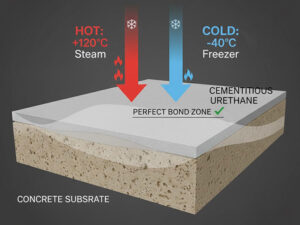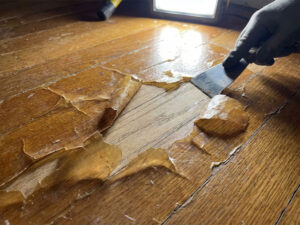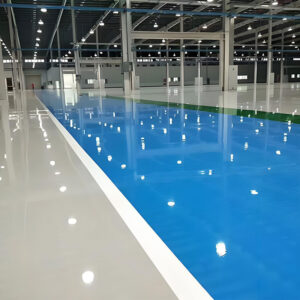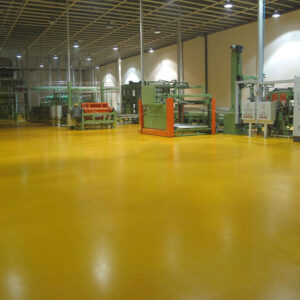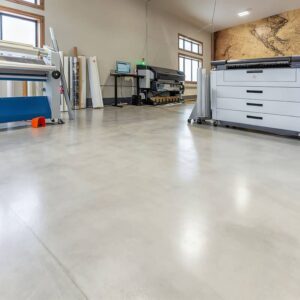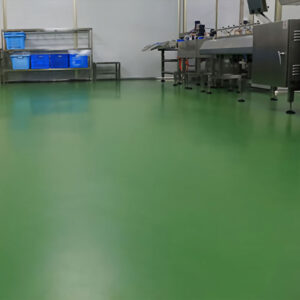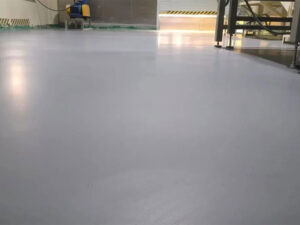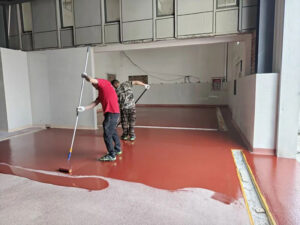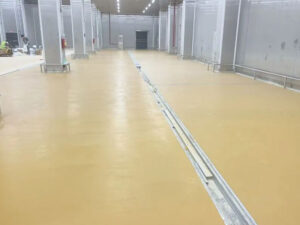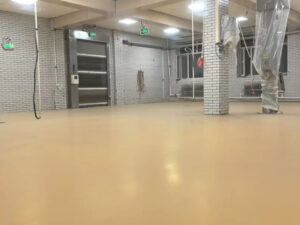- بولي يوريثان مائي الأساس للأرضيات: اختر منتجاً عالي الجودة مناسباً لنوع الأرضية.
- أدوات الصنفرة: ورق صنفرة (120 و150 و220 حصى)، أو كتلة صنفرة أو ماكينة صنفرة مدارية.
- أدوات التطبيق: فرشاة اصطناعية عالية الجودة أو أسطوانة رغوية أو أداة وضع صوف الحمل.
- لوازم التنظيف: صابون وماء وخرق نظيفة ودلو.
- معدات السلامة: القفازات ونظارات السلامة وقناع التنفس.
- لوازم أخرى: شريط لاصق للدهان، وأغطية بلاستيكية، وعصا تقليب.
يُعد البولي يوريثان المائي للأرضيات خيارًا شائعًا لأصحاب المنازل الذين يبحثون عن طلاء نهائي متين وصديق للبيئة وسهل التطبيق. سيرشدك هذا الدليل إلى العملية بأكملها، بدءاً من التحضير وحتى العناية اللاحقة، لضمان الحصول على نتيجة احترافية.
لماذا تختار البولي يوريثان المائي للأرضيات؟
يوفر البولي يوريثان المائي العديد من المزايا مقارنةً بالتشطيبات التقليدية ذات الأساس الزيتي:
- منخفضة المركبات العضوية المتطايرة: تنبعث منها أبخرة ضارة أقل، مما يجعلها أكثر أماناً للاستخدام في الأماكن المغلقة.
- تجفيف سريع: يجف بسرعة، مما يسمح بوضع عدة طبقات في يوم واحد.
- سهولة التنظيف: التنظيف سهل للغاية باستخدام الماء والصابون فقط.
- لمسة نهائية متينة: يوفر حماية ممتازة ضد الخدوش والبقع والتآكل.
- لمسة نهائية شفافة: يحافظ على الجمال الطبيعي للأرضيات الخشبية.
ما ستحتاج إليه: المواد والأدوات
قبل أن تبدأ، اجمع المواد والأدوات التالية:
الخطوة 1: جهز أرضياتك
يُعد التحضير المناسب أمراً بالغ الأهمية للحصول على لمسة نهائية خالية من العيوب.
- أخلِ الغرفة: أزيلي جميع الأثاث والسجاد والأغراض الأخرى من الغرفة.
- نظف الأرضيات: نظف الأرضيات جيداً لإزالة الأوساخ والغبار والشحوم. استخدم مكنسة كهربائية وممسحة رطبة بمنظف لطيف.
- صنفرة الأرضيات: قم بصنفرة الأرضيات لإزالة أي تشطيبات موجودة وتنعيم العيوب وإنشاء سطح يلتصق به البولي يوريثان. ابدأ باستخدام ورق صنفرة 120 حصى ثم انتقل إلى 150 و220 حصى للحصول على سطح أملس.
- مكنسة كهربائية وقطعة قماش مخرمة: نظف الأرضيات بالمكنسة الكهربائية جيدًا لإزالة كل غبار الصنفرة. ثم استخدم قطعة قماش لالتقاط أي جزيئات غبار متبقية.
الخطوة 2: وضع الطبقة الأولى
- قلّب البولي يوريثين: قلّب البولي يوريثان جيدًا قبل الاستخدام لضمان الاتساق المتساوي.
- يوضع بفرشاة أو أسطوانة: باستخدام فرشاة اصطناعية عالية الجودة أو أسطوانة رغوية عالية الجودة، ضع طبقة رقيقة ومتساوية من البولي يوريثان في اتجاه تعريق الخشب. اعمل في أقسام صغيرة لتجنب علامات الالتفاف.
- تجنب الإفراط في العمل: لا تفرط في استخدام البولي يوريثين لأن ذلك قد يؤدي إلى ظهور فقاعات.
- يُترك ليجف: اترك الطبقة الأولى تجف تماماً وفقاً لتعليمات الشركة المصنعة. يستغرق ذلك عادةً من 2-4 ساعات.
الخطوة 3: الرمل والتنظيف بين المعاطف
- صنفرة خفيفة: بمجرد أن تجف الطبقة الأولى، قم بصنفرة الأرضيات برفق باستخدام ورق صنفرة 220 درجة لإزالة أي حبيبات أو عيوب بارزة.
- مكنسة كهربائية وقطعة قماش مخرمة: قم بتنظيف الأرضيات بالمكنسة الكهربائية جيداً واستخدم قطعة قماش لاصقة لإزالة كل غبار الصنفرة.
الخطوة 4: وضع الطبقة الثانية
- ضعي الطبقة الثانية: ضع طبقة ثانية من البولي يوريثان باستخدام نفس تقنية الطبقة الأولى.
- يُترك ليجف: اترك الطبقة الثانية تجف تماماً.
الخطوة 5: الطبقة الثالثة الاختيارية
لمزيد من المتانة، خاصةً في المناطق ذات الازدحام الشديد، يمكنك اختيار وضع طبقة ثالثة من البولي يوريثين. اتبع نفس عملية الطبقة الثانية.
نصائح للعناية اللاحقة بالأرضيات التي تم تشطيبها حديثاً
- انتظر قبل نقل الأثاث: اسمح للبولي يوريثان أن يعالج تماماً قبل إعادة الأثاث إلى الغرفة. يستغرق ذلك عادةً 24-48 ساعة.
- استخدم الوسادات الواقية: ضعي وسادات واقية تحت أرجل الأثاث لمنع الخدوش.
- نظف بانتظام: نظف الأرضيات بانتظام باستخدام ممسحة رطبة ومنظف لطيف. تجنب استخدام المواد الكيميائية القاسية أو المنظفات الكاشطة.
- أعد تطبيقه حسب الحاجة: بمرور الوقت، قد يتآكل طلاء البولي يوريثان بمرور الوقت. يُعاد وضعه حسب الحاجة للحفاظ على الحماية والجمال.
الأسئلة الشائعة (FAQ)
س: ما المدة التي يستغرقها البولي يوريثان المائي حتى يجف؟
ج: يختلف وقت التجفيف حسب المنتج والظروف البيئية، ولكنه يستغرق عادةً من 2 إلى 4 ساعات لكل طبقة.
س: هل يمكنني استخدام البولي يوريثان المائي فوق الطلاء القديم؟
جواب: نعم، ولكن من المهم صنفرة الطلاء القديم جيداً لضمان الالتصاق المناسب.
س: كم عدد طبقات البولي يوريثان المائي التي يجب أن أضعها؟
ج: عادةً ما تكون طبقتان كافيتان، ولكن يمكن وضع طبقة ثالثة لمزيد من المتانة.
س: ما هي أفضل طريقة لتنظيف الأرضيات المصنوعة من البولي يوريثان المائي؟
ج: استخدم ممسحة رطبة ومنظف لطيف. تجنبي استخدام المواد الكيميائية القاسية أو المنظفات الكاشطة.
إن تطبيق البولي يوريثان المائي للأرضيات هو مشروع يمكن التحكم فيه بنفسك ويمكنه تغيير مظهر الأرضيات الخشبية ومتانتها. من خلال اتباع هذا الدليل التفصيلي خطوة بخطوة واستخدام مواد عالية الجودة، يمكنك الحصول على مظهر احترافي يدوم لسنوات قادمة. تذكر أن تعطي الأولوية للسلامة وخذ وقتك واستمتع بالعملية!

